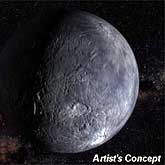Not Quite A Planet
 Astronomers have dubbed it 'Quaoar' (pronounced kwa-whar) after a Native American god. It lies a billion kilometers beyond Pluto and moves around the Sun every 288 years in a near-perfect circle. Until recently it was just a curious point of light. That's all astronomers could see when they discovered it June, 2002 using a ground-based telescope. But now it's a world.
Astronomers have dubbed it 'Quaoar' (pronounced kwa-whar) after a Native American god. It lies a billion kilometers beyond Pluto and moves around the Sun every 288 years in a near-perfect circle. Until recently it was just a curious point of light. That's all astronomers could see when they discovered it June, 2002 using a ground-based telescope. But now it's a world.
NASA's Hubble Space Telescope has measured Quaoar and found it to be 1300 km wide. That's about 400 km wider than the biggest main-belt asteroid (Ceres) and more than half the diameter of Pluto itself. Indeed, it's the largest object in the solar system seen since the discovery of Pluto 72 years ago.
Quaoar is greater in volume than all known asteroids combined. Researchers suspect it's made mostly of low-density ices mixed with rock, not unlike the makeup of a comet. If so, Quaoar's mass is probably only one-third that of the asteroid belt. Quaoar is the record-holder - a tantalizing glimpse of perhaps bigger things to come.
About the Author
NASA Marshall Space Flight Center
 The George C. Marshall Space Flight Center, located in Huntsville, Alabama, is the U.S. government's civilian rocketry and spacecraft propulsion research center. As the largest NASA center, MSFC's first mission was developing the Saturn launch vehicles for the Apollo program.
The George C. Marshall Space Flight Center, located in Huntsville, Alabama, is the U.S. government's civilian rocketry and spacecraft propulsion research center. As the largest NASA center, MSFC's first mission was developing the Saturn launch vehicles for the Apollo program.


